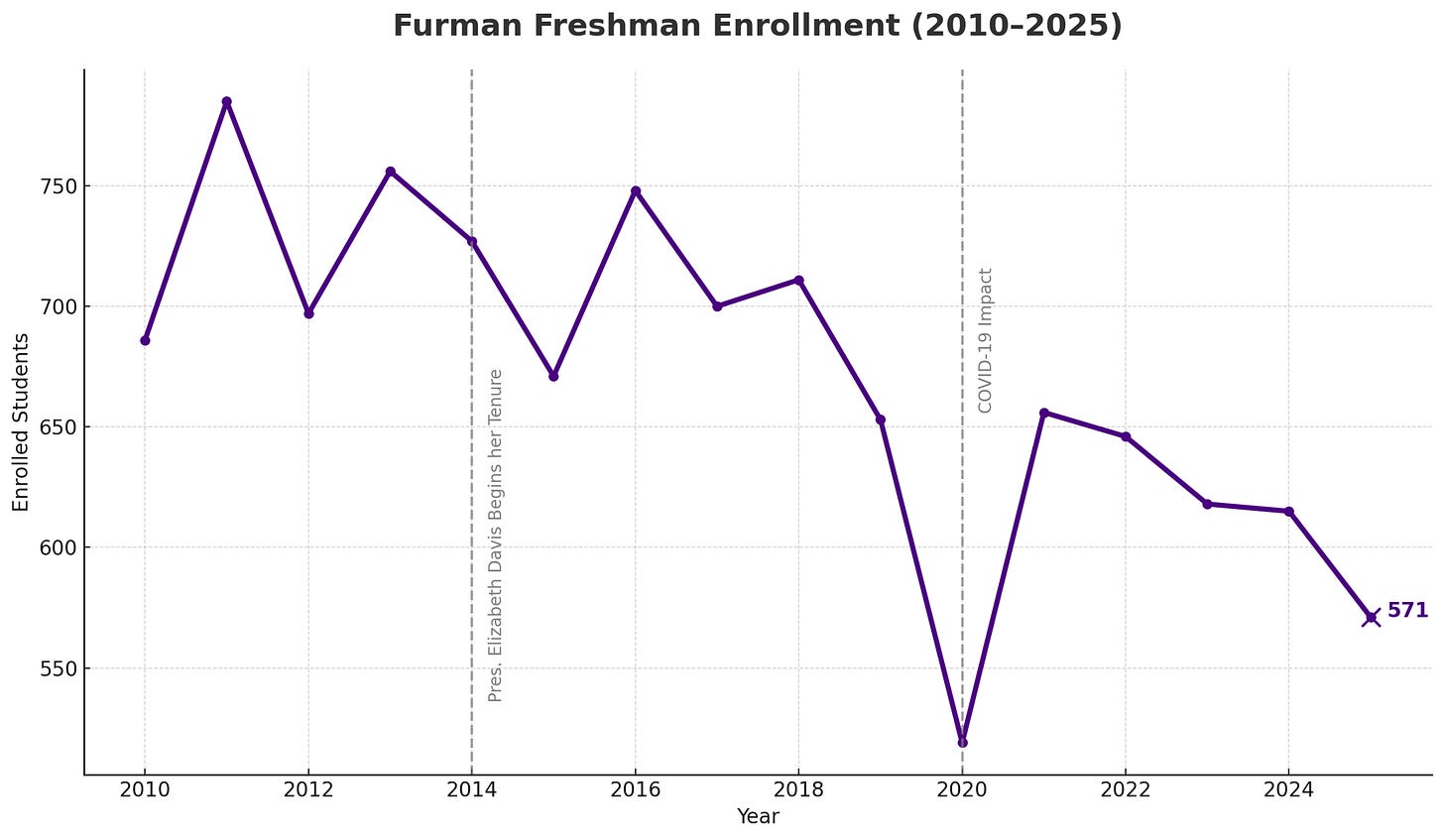Welcome to the Data Din. A sharp, visual snapshot of key data about Furman University—from admissions trends to faculty composition.
This week, we bring you data on Furman’s freshman enrollment.
The class of 2029 starts “Fall Orientation” at Furman this Thursday (August 21). Now, I could write an entire editorial outlining the numerous problems with Furman’s orientation program — not least of which is that the whole thing is replete with political indoctrination.
But instead, I want to present data about this new class of Paladins that provide context for the big story of the month: Fitch revising Furman’s bond rating to negative.
One of the main causes behind Fitch’s negative assessment is Furman’s “increasingly vulnerable enrollment demand profile.” In other words, they’re worried that Furman will struggle financially because it won’t bring in enough students each year.
To support this claim, Fitch cites the fact that this incoming class of Paladins is small, writing that “undergraduate student deposits of 571 in April 2025” were “slightly below the 621 level in the prior year.” And a quick reference to Furman’s common data sets shows that this diminishment in the size of the incoming freshman class is part of a broader trend. The number of freshmen enrolling each fall has dropped consistently since President Elizabeth Davis took over in 2014:
This trend is driven by many different factors.
Some are national, such as:
Demographic decline — Falling birth rates over the past few decades have reduced the pool of college-aged students. Colleges call this the “Enrollment Cliff.”
Rising costs — Tuition and overall college costs have surged far beyond inflation, outpacing both state funding and family incomes.
The total cost of obtaining an undergraduate degree at Furman now stands at nearly $75,000 per year (though most students aren’t paying full price as the university has been forced to increasingly discount tuition to boost enrollment — another of Fitch’s concerns).
Doubts about return on investment — Americans have become increasingly skeptical of the return on investment for a four-year degree.
Cultural animus — Schools around the countty have prioritized DEI over more traditional American values, driving students away.
Covid-19 — Many students delayed or skipped college altogether because of the pandemic. First-year enrollment in fall 2020 dropped by more than 13% nationally.
But some are particular to Furman:
Competitive regional environment — Furman competes in an increasingly crowded regional market, with larger public universities and lower-cost private colleges across the Southeast drawing from the same shrinking pool of students.
Skip-over school status — Jeff Selingo, who writes about colleges and universities, says that Furman is a “skip-over-school” — caught between the Ivies and other elite privates and those cheaper regional flagships with generous scholarships.
And — it must be said — much of this is self-inflicted by the current administration.
I’m not sure if Furman’s administration would acknowledge it now, but when I was a student working in admissions — around 2019-2021 — I remember clearly being informed that Furman was pursuing a strategy of increasing the number of applicants while decreasing the number of accepted students.
The idea was to decrease Furman’s acceptance rate and thus increase its prestige (and position in the national rankings).
Such a strategy has clear upsides, but the risk is exactly the situation Furman finds itself in now. Accepting fewer students leads to fewer students enrolling. Fewer students enrolling leads to strain on the operational budget. And this strain leads to Fitch revising your bond rating!
Such a strategy also raises the question: What kind of school should Furman aspire to be?
A lower-tier elite private school that attracts the best and the brightest from around the world?
Or a top-tier regional private school that serves the Carolinas and surrounding areas?
Let us know what you think — and why — in the comments!




I and many others so appreciate the work you are doing with this newsletter and advocacy group. My perspective as a 2007 grad is that Furman started going downhill when they started fixing things that weren’t broken. I never wanted or needed Furman to be anything but a good regional school that allowed traditional values alongside critical thinking. I then went to a nationally known grad school and that worked out just fine.
At our daughters’s orientation in August 2022, Furman proudly announced that they had an unprecedented number of applicants. I believe they said it was 7500, and that something like 6 or 8% of those were accepted. There is no doubt that orientation was focused on political indoctrination. For starters, every presentation given by a student began with their announcement of their pronouns. In addition, at the table hosted by the Center for Inclusive Communities, our then 12-year-old was forced to announce her pronouns via the myriad pronoun/neopronoun buttons on the table before she could obtain any of the merchandise being offered at the table. We regretted our decision that very day. And we have seen the situation worsen, with ideologically captured programs featured in the compulsory Cultural Life Program, such as the history of transgenderism being shown multiple times in one month. Needless to say, Furman was extremely successful in completely indoctrinating our daughter. And we don’t know what it will take to extricate her from that.